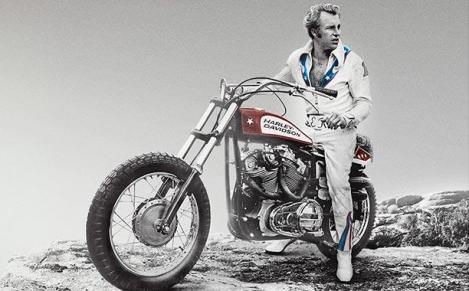
What: Film Review
Directed by: Daniel Junge
Written by: Daniel Junge, Davis Coombe
Produced by: Daniel Junge, Jeff Tremaine, Johnny Knoxville, Mat Hoffman, Brendan Kiernan
Featuring: Evel Knievel, Robbie Knievel, Linda Knievel, Johnny Knoxville, Kelly Knievel, Tony Hawk
Language: English
Running Time (in min.): 100 minutes
Rating: Not Yet Rated
Official Selection of the 2015 Sundance Film Festival – U.S. Documentary Competition
****
The legendary stuntman and American cultural totem Evel Knievel gets a jaunty, if standard, biographical documentary all to himself in the newest feature from Oscar- and Emmy-winning filmmaker Daniel Junge. With utter confidence and the backing of production partners Jeff Tremaine and Johnny Knoxville (who appears as a talking head throughout), Junge and co-writer Davis Coombe give us the man/myth/legend in full-life portraiture in Being Evel, which premiered in competition at the 2015 Sundance Film Festival.
As usual for the filmmakers behind Saving Face [2012] and last year’s charming Beyond the Brick: a LEGO Brickumentary [2014], style here is highly professional, completely straightforward, and impersonal to a T. Knievel’s basic position in entertainment history is well-known, but Junge and his merry band of talking-heads – ranging from the Knievel family to Evel’s business partners to admirers like Knoxville and Tony Hawk – provide a “fuller” picture of the notorious daredevil. Each has some positive words for the international hero and some bad things to say, too, just so we know that the movie’s subject was human like the rest of us. We all have our flaws, right?

The distant and unobtrusive strategy at which Junge has proven himself a master with other subjects feels ultimately like a disservice to one of the more fascinating subjects of recent nonfiction filmmaking. What defined Knievel’s career, the film argues, was his immense charisma and a one-of-a-kind position in the minds of fans everywhere: as an actor, a motorcyclist, an alcoholic brute, and a public figure, he reached a very uncommon echelon. His increasingly wild stunts were some of the country’s most-watched television events of all time, and cultural bonding experiences. Evel was at once a sex god, a man’s man, a celebrity, and a self-styled artist. It’s thus confusing to see a movie that thinks for itself so little, without a hint of self-interrogation or reflexivity to boot.
I’m not insisting that all documentaries should be metatexutal, by any means; but they could at least contain some aesthetic personality. Junge and Coombe opt for a chronological approach to Knievel’s entire career, from his rambunctious childhood in Butte, Montana to his tragic death, unbelievably, by pulmonary fibrosis in 2007. All the tentpoles of his public life – his first and second marriages; several near-fatal jumps at Caesar’s Palace and Idaho’s Snake River; and his attempts to break into showbusiness – are on display in the form of archival footage, family photographs, and interviews. We’ve seen this kind of movie so many times before that by the time we learn that A&E and the History Channel collaborated on the film’s production, our eyes roll in time with the credits. Ah, of course – this is neither an exposé nor an adulatory love-letter to Knievel. It’s a “warts-and-all” flick, the kind of documentary that tries to have its cake (a critical look at Knievel’s often despicable behavior and persona) and eat it, too (an affectionate ode to an icon.)
Ultimately, what makes Being Evel a letdown is that despite exclusive interviews with contemporary FPs (famous people) and some not-so-well-known Knievel insiders, the movie fails to be formally interesting as a stand-alone. Fans of the Knievel mythos will be forced to flock to History Channel when the film shows later in 2015, and some will be satisfied – after all, Junge, Coombe (who also edited splendidly), and the team of popular producers manage to make a hundred minutes of run time go by without a hitch. But those hoping that Junge’s sixth feature-length doc, his first to play at Sundance, might have reflected an old dog’s use of new tricks will be sorely disappointed.

